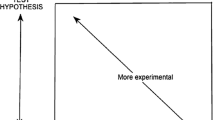Abstract
Benchmarks for Science Literacy (AAAS 1993) lists for four gradelevels the steps by which students might achieve science literacy before leaving high school. These steps and the conceptual connections among them are now being “mapped” to suggest where anyone idea or skill comes from, what it is connected to, and where it leads. A set of 49 such “strand maps” appears in Atlas of Science Literacy (AAAS 2001). This paperdescribes strand maps in general and examinesthree draft maps titled Evidence and Reasoning, Scientific Investigations, and Scientific Theories, which together represent one section of Benchmarks Chapter 1, on scientific inquiry. The maps do not prescribe any particular curriculum, but can aid in planning a variety of curricula, analyzing instructional materials, assessing student understanding, and can be used in professional development for teachers.
Similar content being viewed by others
References
Allen, R.D., Statkiewitz, W.R. & Donovan, M.: 1983, ‘Student Perceptions of Evidence and Interpretations’, in J. Novak (ed.), Proceedings of the International Seminar: Misconceptions in Science and Mathematics, Cornell University, Ithaca, NY, pp. 79-83.
American Association for the Advancement of Science: 1989, Science for All Americans, Oxford University Press, New York.
American Association for the Advancement of Science: 1993, Benchmarks for Science Literacy, Oxford University Press, New York.
American Association for the Advancement of Science: 2001, Atlas of Science Literacy, Author, Washington, DC.
Kuhn, D.: 1991, The Skills of Argument, Cambridge University Press, Cambridge.
Mokros, J. & Russell, S.: 1992, ‘Children's Concepts of Average and Representativeness’, Working Paper 4-92, TERC, Cambridge, MA.
Pollatsek, A., Lima, S. & Well, A.: 1981, ‘Concept of Computation: Students' Understanding of the Mean’, Educational Studies in Mathematics 12, 191-204.
Stinner, A.: 1996, ‘Providing a Contextual Base and a Theoretical Structure to Guide the Teaching of Science from Early to Senior Years’, Science & Education 5, 247-266.
Vosniadou, S.: 1991, ‘Designing Curricula for Conceptual Restructuring; Lessons from the Study of Knowledge Acquisition in Astronomy’, Journal of Curriculum Studies 23, 219-237.
Wollman, W.: 1977a, ‘Controlling Variables: Assessing Levels of Understanding’, Science Education 61, 371-383.
Wollman, W.: 1977b, ‘Controlling Variables: A Neo-Piagetian Developmental Sequence’, Science Education 61, 385-391.
Author information
Authors and Affiliations
Rights and permissions
About this article
Cite this article
Ahlgren, A., Wheeler, S. Mapping the Steps toward Basic Understanding of Scientific Inquiry. Science & Education 11, 217–230 (2002). https://doi.org/10.1023/A:1015254610226
Issue Date:
DOI: https://doi.org/10.1023/A:1015254610226




